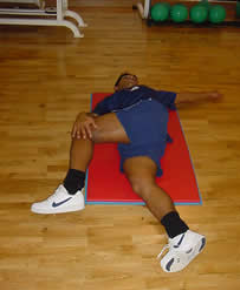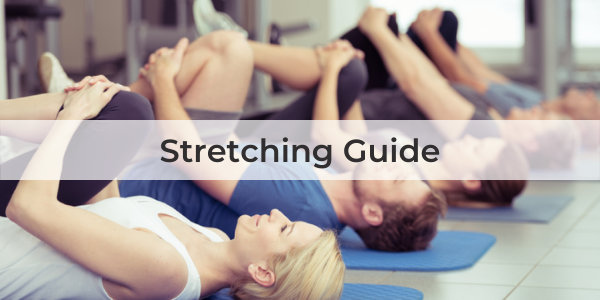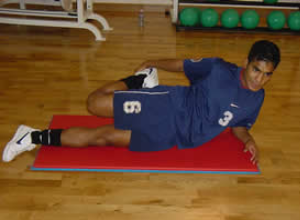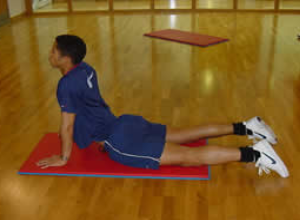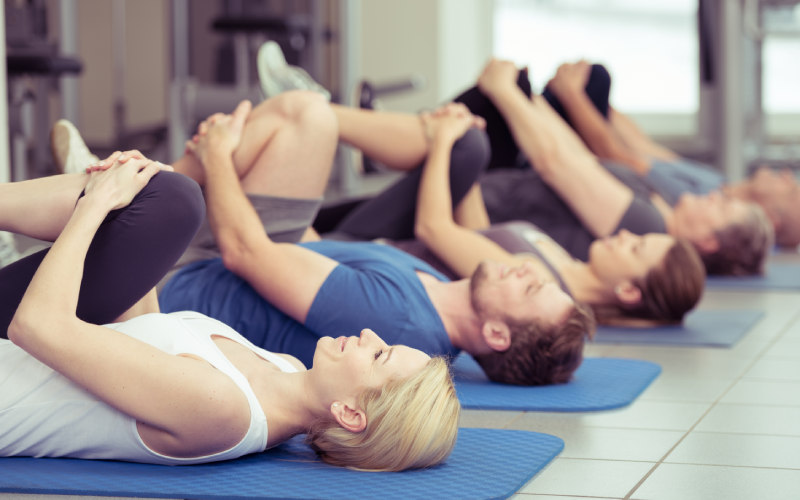
It has long been suggested that performing a warm up and a cool down before and after sporting activity can help reduce the incidence of injury and promote recovery following training and matches. Central to these practices is improving flexibility through stretching. Here, we guide you through the science of stretching, explain the various techniques for the level of stretching appropriate to requirements, and provide a comprehensive programme of stretches. So let’s get started.
Stretching Science
In order to understand correct stretching techniques it is beneficial to know a little about the biochemical and physiological properties of the soft tissues that are being stretched.
All soft tissues (muscles, tendons, joint capsules, fascia, skin) are more extensible when they are warm. This is because they are thermo-elastic. This is like a blacksmith working with a horseshoe; when the horseshoe is hot it can be stretched and manipulated, but when it is cooled it is rigid and inflexible. All stretching is ineffective if it is performed when the body is cold, and should therefore be preceded by a series of warm-up exercises to increase tissue temperature.
Muscles and tendons have a neural reflex arc that prevents excessive stretching, or tension developing. Receptor nerves within the muscle are sensitive to changes in muscle length and tension. When a muscle is stretched, the muscle spindles send a message to the central nervous system to cause a reflex contraction of the muscle in order to prevent stretch damage. However, if the stretch is maintained for more than 6 seconds the Golgi tendon organs respond to the change in muscle tension by sending a signal to the central nervous system which causes the muscle to relax. This means that stretching exercises should be done slowly with a gradual increase in the range of movement every few seconds. The total duration of the stretch should be about 20 seconds.
Guide to Stretching
There are several methods of stretching soft tissues. If a player has been injured, the physiotherapist may do the stretches passively. In the pre-match warm up the players do the stretching exercises themselves – this is known as ACTIVE stretching. This requires relaxation and sustained stretching of a muscle. The degree of stretching can be subdivided as follows:
Simple Stretch
A simple stretch is usually used in the rehabilitation of injured players, rather than with fit players. The player should feel very mild tension in the muscle and this should be held for 10 to 30 seconds.
Developmental Stretch
A developmental stretch follows on from a simple stretch in that the feeling of tension is present over a greater range of joint movement. This tension should disappear after 15 seconds; if it does not, the player is moving into the drastic range and should ease off. The stretch should be held for 20 to 30 seconds.
Drastic Stretch
A drastic stretch gives the player a constant feeling of pain and should be avoided. This sensation is often wrongly interpreted by the player as being beneficial. In fact this type of stretch causes micro-trauma to muscle tissue, which causes a gradual loss of elasticity and increases the risk of muscle injury.
The Stretches
Please note, these exercises are for guidance only and should be supervised by a qualified physiotherapist. If you have, or have had, an injury or you are suffering from a medical condition you should not do such exercises without first consulting a medical practitioner.
Shoulder & stomach stretch
The fingers are linked together and the palms of the hands pushed up towards the ceiling. The stretch is felt under the shoulders and in the stomach muscles.
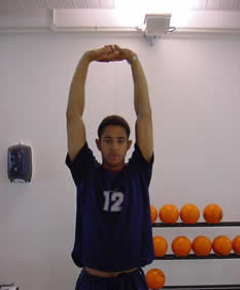
Shoulder & trunk stretch
Lying on the back, and keeping one leg to the ground and straight, the opposite leg is bent, brought over and pushed down gently with the hand. The stretch is felt in the middle of the back and in the buttock.
The stretch is then repeated on the other side.
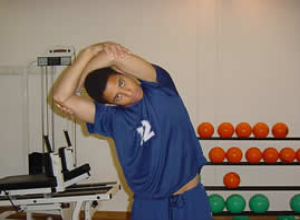
Shoulder & tricep stretch
The elbow is bent and grasped with the opposite hand. The hand is then gently pushed down the back. The stretch is felt in the back of the upper arm.
The stretch is then repeated on the other side.
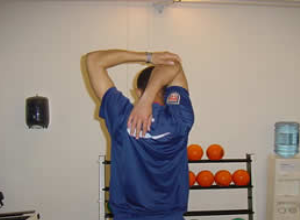
Shoulder stretch
The hands are linked behind the back, with the arms out straight. The hands are then gently pushed back. The stretch is felt at the front of the shoulders.
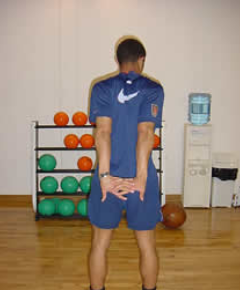
Groin stretch (gentle)
Lying on the back with the soles of the feet together, the knees fall slowly outwards. The stretch is felt high up in the groin.
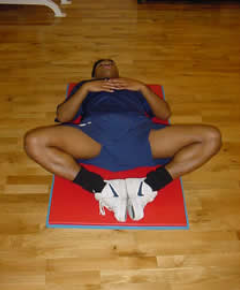
Groin stretch (intermediate)
Sitting on the floor with the soles of the feet together, and sitting up straight, the feet are grasped. The stretch is felt in both sides of the groin and down the inside of both thighs.
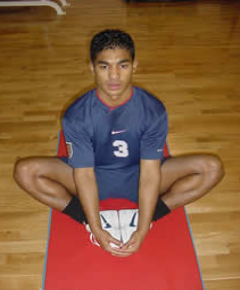
Groin stretch (advanced)
Sitting on the floor with the soles of the feet together, and sitting up straight, the elbows are used to gently push the knees apart. The stretch is felt in both sides of the groin and down the inside of both thighs.
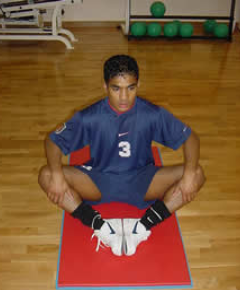
Glute stretch
Sitting on the floor with one leg out straight, the opposite knee is bent and the foot is placed over the straight leg. The hands are then used to gently push the bent knee up towards the opposite shoulder. The stretch is felt in the buttock.
The stretch is then repeated on the other side.
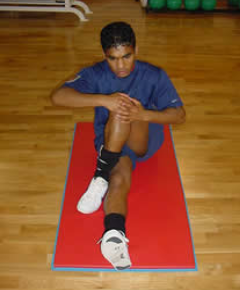
Calf stretch
The feet are placed stride width apart with the front leg slightly bent. The body weight is transferred forward whilst keeping the heel of the back foot on the ground. The stretch is felt down the back of the calf.
The stretch is then repeated on the other side.
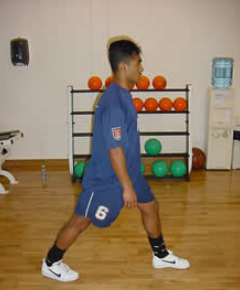
Achilles stretch
Standing with the feet stride length apart, and with both knees slightly bent, the body weight is transferred forwards whilst keeping the heel of the back foot on the ground. The stretch is felt at the bottom of the calf.
The stretch is then repeated on the other side.
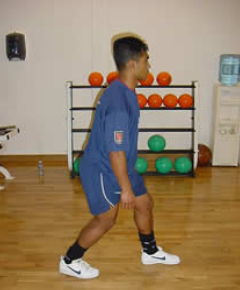
Hamstring & back stretch
One foot is placed slightly in front of the other, with the front leg straight and the back leg slightly bent. Bending forwards, the hands slide down the front of the shin. The stretch is felt in the back of the knee.
The toes are pushed down to the floor to feel the stretch more in the middle of the hamstring muscle.
The stretch is then repeated on the other side.
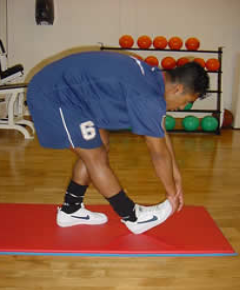
Note: Keep your pelvis square on to the surface you are stretching on and don’t rotate to the side. Also, by bending the knee slightly, stretching of the upper part of the hamstring muscles is more effective.
Hamstring Stretch
The leg is lifted in front of the body and the heel is rested on a flat surface, with the leg out straight. Keeping the back straight, and the other leg bent, the hands slide slowly down the shin. The stretch is felt in the middle of the hamstring muscle. The stretch is then repeated on the other side.
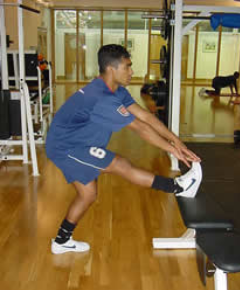
Hip flexor muscle stretch
The feet are placed stride width apart, with the front knee bent. The body weight is transferred forwards and the pelvis pushed forward. The stretch is felt at the front of the hip.
The stretch is then repeated on the other side.
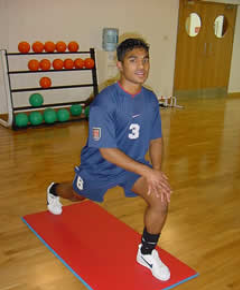
Thigh muscle stretch
Lying on the side with the weight of the upper body resting on a bent elbow, the uppermost ankle is pulled towards the buttock. The bent knee is slowly moved backwards. The stretch is felt down the front of the thigh.
The stretch is then repeated on the other side.
Shoulder stretch
The right arm is placed over the left shoulder, and the right elbow grasped with the left hand. The elbow is gently pushed towards the shoulder. The stretch is felt over the outside of the shoulder.The stretch is then repeated on the other side.
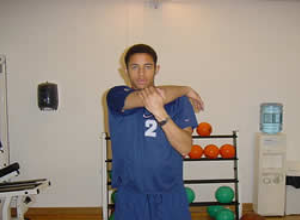
Back & shoulder stretch
The feet are placed shoulder width apart and facing forwards. The fingers are linked and the arms pushed out straight with the palms to the front. The arms are then twisted and pushed to one side. The stretch is felt on the outside of the shoulder and in the middle of the back. The stretch is then repeated to the other side.
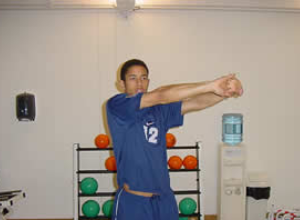
Shoulder & pectoral stretch
The hands are linked behind the back, with the arms out straight. The hands are then gently pushed back. The stretch is felt at the front of the shoulders.
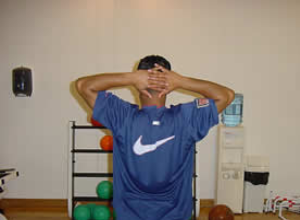
Back stretch
The feet are placed shoulder width apart and facing forwards. The hands are placed together and the top half of the body gently twisted round to one side. The stretch is felt in the middle of the back. The stretch is then repeated on the other side.
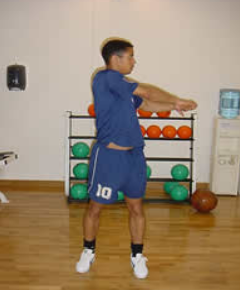
Abdominal stretch
Lying on the front with the hands underneath the shoulders, the head and shoulders are gently pushed up with the arms. The pelvis is kept to the ground. The stretch is felt in the front of the stomach.
Back & buttock stretch
Lying on the back, and keeping one leg to the ground and straight, the opposite leg is bent, brought over and pushed down gently with the hand. The stretch is felt in the middle of the back and in the buttock.
The stretch is then repeated on the other side.
